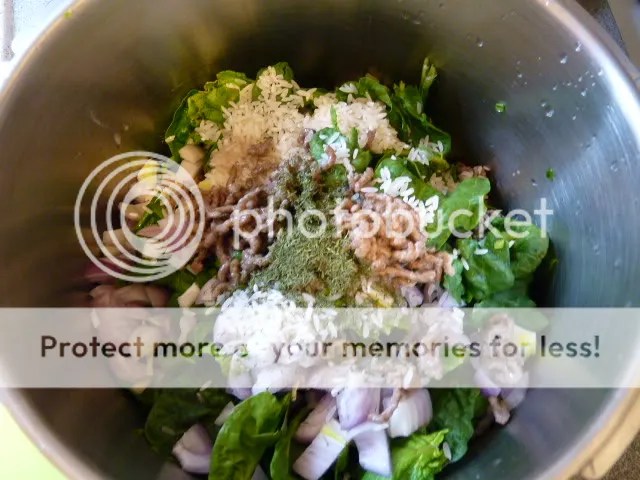
I found some surimi in the supermarket freezer. Surimi, if you don’t know, is what used to be called “imitation crab.” It’s cheap fish that’s flavored and colored to look like crab (or lobster, or whatever else you want).

I like it because it’s quite low calorie and a good source of protein, without a high price. However, it won’t work in every crab recipe. I really liked the look of the Summer Crab Risotto on Brokeass Gourmet, which Gabi, the author, figures works out to $16.50 to serve 3-4 people. That’s a bit steep for me but I played around with it a bit, and managed to get it to fit our more frugal budget.

You can use any kind of rice you like. The rumor that you have to use arborio rice for risotto to work is just a rumor. I used to use brown rice all the time, but for frugality reasons, now I use standard medium grain white rice. Arborio is hard to find in Greece outside of the major cities; Carolina is the more popular Greek choice for risotto; it doesn’t make a very big difference.


Start by sauteing the green onions and garlic in an olive-oil sprayed nonstick pan. I used purple onions but it doesn’t matter. While you’re doing that, boil some water in a kettle and pour over a chicken bouillon cube (I break it up into powder first). You can use fresh chicken stock or canned if you have it, of course, but the cube is the cheapest way. You’ll need about 3-4 cups of stock.

When the onions are soft and starting to take on a little color, stir in the rice for a few minutes – this will help develop its flavor a little further.

Pour in some stock while stirring constantly. The typical way to make risotto is to keep adding stock as it evaporates and is absorbed, while stirring the whole time, and that’s how I do it also. Keep adding stock so that the rice has a chance to cook.


Add the parsley if you’re using dried parsley, and the corn. If you’re using fresh parsley, add it at the end. I used canned corn; you can use frozen or fresh if you like.


Stir it all to incorporate, and add the crab.

Continue adding stock if at any point it dries out. I don’t like my risottos really wet but you don’t want it to be dry either. Use the stock and heat to find the right balance.

Stir in the cheese, and fresh parsley if using.

Crab Risotto
serves 2
2 green onions, chopped
3 garlic cloves, crushed
200g rice
100g surimi (imitation crab), cut into small pieces
1/3 cup canned corn, rinsed
1 tbsp dried parsley or 3 tbsp fresh parsley
1 chicken bouillon cube, dissolved in 4 cups / 1 liter boiling water
2 tbsp grated myzithra or parmesan cheese
1. Saute the onions and garlic in a nonstick pan sprayed with a little olive oil.
2. Stir in the rice for several minutes. Pour in the chicken stock, a ladle-ful at a time, allowing it to absorb the water. Stir continuously. This should take about 10-15 minutes.
3. When the rice is soft, stir in the corn, dried parsley, and surimi. Stir for several more minutes, adding more stock as needed.
4. Stir in the parmesan and fresh parsley if using. Serve.
Nutritional Information
per serving (i.e., 1/2 of total recipe)
535 calories
3g fat (0g saturated, 3g unsaturated)
110g carbohydrate
16g protein
3g dietary fiber
10mg cholesterol (3% DV)
443mg sodium (18% DV)
286g potassium (8% DV)
Contains a significant amount (+10% DV) of the following:
thiamin, niacin, vitamin B-6, phosphorus, selenium, magnesium, zinc, iron, vitamin B-12, manganese, and copper.
You might also like:
Afghani orange pilaf
Sesame chicken
Lentils & rice



























